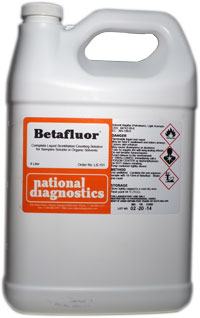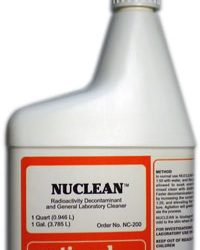Liquid Scintillation
Betafluor
$106.00
Quantity discount when you buy 4 or more bottles!
- For Non-Aqueous Samples
- High Counting Efficiency
- Ready-To-Use
- Economical
Description
Quantity discount when you buy 4 or more bottles!
- For Non-Aqueous Samples
- High Counting Efficiency
- Ready-To-Use
- Economical
Betafluor is a pre-mixed scintillation solution designed to count virtually all nonaqueous and organic samples with greatly improved efficiencies. Betafluor contains all necessary primary and secondary fluors and solvents. It is precisely quality controlled to assure lot-to-lot consistency and reproducibility of results. Simply combine the nonaqueous sample with 10-15 ml Betafluor, shake well and count.
Betafluor has lower backgrounds and improved quench resistance over toluene-based scintillators, and tritium efficiencies over 55% are obtainable. Betafluor is formulated with our exclusive high flash point, low evaporation rate LSC solvent which offers higher counting efficiencies as well as reduced fire hazard and exposure to aromatic solvents.
Storage: Betafluor is best stored tightly capped in a cool dry area. No deterioration has been observed on storage for five years at room temperature or heating to 50 oC for one week or cooling to -30 oC for one week. Flash point 114 oF (TCC). Shipping weight 12 lbs. (1×1 gal.), 49 lbs. (4 gals.).
Additional information
| Weight | 9 lbs |
|---|---|
| Dimensions | 15 × 10 × 13 in |
Safety Overview
Safety Summary (see SDS for complete information before using product):
EMERGENCY OVERVIEW – IMMEDIATE HAZARD
POISON! DANGER! UNDILUTED COMPONENTS CAUSE BURNS TO ANY AREA OF CONTACT. MAY BE FATAL IF SWALLOWED. HARMFUL IF INHALED. CONTACT WITH OTHER MATERIALS MAY CAUSE FIRE.
- Waste Disposal Issues in Scintillation Counting
- The Complete Scintillation Cocktail
- Radioactive Emissions and the Use of Isotopes in Research
- Preparing Tissue Samples for Scintillation Counting
- Preparing Samples in PAGE Gels for LSC
- Mechanism of Liquid Scintillation Counting
- Measurement of Radiation and Isotope Quantitation
- Liquid Scintillation Signal Interpretation
- Liquid Scintillation and Radiation Safety
- HPLC Flow Counting
- Counting Samples on Cellulose-Ester Filters
- Counting Samples from TLC Plates by LSC
- Counting Efficiency and Quenching
- Counting Carbon Dioxide by LSC
- Chemiluminescence and Static Electricity
- Assaying Discrete Samples by Liquid Scintillation Counting



